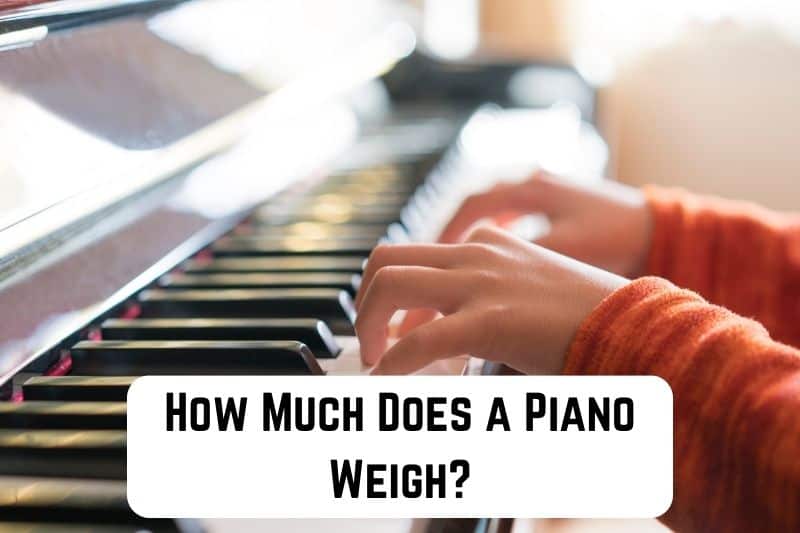When people think about purchasing a piano, one of the first questions that often comes to mind is how much a piano weighs. As a piano enthusiast, I can undoubtedly say that understanding the weight of a piano is essential, especially when moving or installing one in your home.
In this article, I’ll discuss the factors contributing to a piano’s weight and how different pianos can significantly vary in size and heaviness.

The weight of a piano mainly depends on the type and materials used in its construction. Generally, there are three categories of pianos: upright, grand, and digital.
Upright pianos, also known as vertical pianos, have a compact design, making them suitable for more modest spaces. Grand pianos, in contrast, have a horizontal frame, providing a richer and more resonant sound. Digital pianos, on the other hand, are electronic and come in various sizes and designs.
Read: How Much Does a Grape Weigh? (Quick Guide)
Baby grand pianos typically weigh around 500 to 600 lbs (227 to 272 kg). Parlor grand pianos are larger and can weigh between 700 and 800 lbs (318 to 363 kg). Concert grand pianos, the largest category, can weigh anywhere from 900 to 1200 lbs (408 to 544 kg).
Various Piano Types and Their Weights
Grand Pianos

I have noticed that grand pianos can vary significantly in size and weight. To help you understand better, consider these three standard sizes:
- Baby grand pianos typically weigh around 500 to 600 lbs (227 to 272 kg).
- Parlor grand pianos are larger and can weigh between 700 and 800 lbs (318 to 363 kg).
- Concert grand pianos, the largest category, can weigh anywhere from 900 to 1200 lbs (408 to 544 kg).
Upright Pianos

Regarding upright pianos, they are generally lighter and more compact than their grand counterparts. The common types and their approximate weights are:
- Spinet pianos are the smallest and can weigh around 200 to 300 lbs (90 to 136 kg).
- Console pianos, slightly larger, weigh somewhere between 300 to 400 lbs (136 to 181 kg).
- Studio pianos weigh around 400 to 500 lbs (181 to 227 kg).
Digital Pianos

Digital pianos are known for being lighter and more portable than acoustic pianos. The weight largely depends on the make and model, but generally:
- Portable digital pianos weigh as little as 25 to 50 lbs (11 to 22 kg).
- Full-sized digital pianos with weighted keys can weigh around 60 to 100 lbs (27 to 45 kg).
Toy Pianos

Toy pianos are meant for young children and are typically relatively light, making them easy for kids to maneuver. Most weigh between 5 and 20 lbs (2 to 9 kg), depending on size, material, and design.
How Much Does a Baby Grand Piano Weigh?

When I first started looking into baby grand pianos, I noticed that their weight varies quite a bit. A baby grand piano usually weighs 500 to 1,200 pounds (227 to 544 kg). This range is primarily influenced by the piano’s size, materials, and overall design.
I found that one of the factors contributing to the weight of a baby grand piano is its size. Baby grand pianos come in various lengths, typically between 4’7″ and 5’7″ (1.4 to 1.7 meters). A longer baby grand will generally be heavier than a shorter one due to the increased materials used in its construction.
Another aspect to consider when estimating the weight of a baby grand piano is the materials used in building it. Pianos are made from wood, metal, and other materials, all contributing to the overall weight.
Some manufacturers may use heavier or more dense wood, which could add to the overall weight. Metal components, like the cast iron plate, can also vary in weight.
Lastly, the design of a baby grand piano can influence its overall weight. Some pianos incorporate more intricate designs, additional features, or different construction methods, which can result in a heavier or lighter instrument.
To give you a better idea of the various weights of baby grand pianos, here are a few examples:
- Yamaha GB1K: This baby grand piano measures 5’0″ (1.5 meters) and weighs approximately 600 pounds (272 kg).
- Steinway & Sons Model S: This model has a length of 5’1″ (1.55 meters) and weighs around 540 pounds (245 kg).
- Kawai GM-10: The length of this baby grand is 5’0″ (1.5 meters), and it weighs approximately 574 pounds (260 kg).
How Much Does a Spinet Piano Weigh?

When I first started exploring the world of pianos, I was surprised by the variety of sizes, shapes, and weights. One type of piano that caught my eye was the spinet piano.
This smaller piano has a unique charm, and its lighter weight compared to other pianos makes it an exciting and accessible choice for many.
A spinet piano typically weighs between 300 to 500 pounds (136 to 227 kilograms). The variation in weight is due to differences in materials, construction, and the specific model or manufacturer of the piano.
A spinet piano is lighter than grand pianos, which can weigh anywhere from 500 to 1,200 pounds (227 to 544 kilograms), or upright pianos, which usually weigh between 400 and 900 pounds (181 to 408 kilograms).
There are several reasons why the spinet piano is lighter than other pianos:
- Size: Spinet pianos are among the smallest types of pianos available. They have a shorter height, which ranges from 36 to 40 inches, compared to full-size uprights that can reach up to 60 inches in height.
- Simplified Mechanism: The spinet’s internal mechanism, known as the action, is typically simpler and more compact compared to other piano types, which results in a reduced weight.
- Materials: Certain spinet pianos are constructed with materials such as lightweight wood or even plastics, which can lead to a lower overall weight.
Because of their reduced weight, spinet pianos are often more transportable and can be more easily moved to different locations within a home or other space. Their smaller size makes them ideal for those with limited space or who prefer a more compact, cozy piano.
Components Influencing Piano Weight
As a piano enthusiast, I believe it’s essential for all of us to know the factors impacting the weight of a piano.
In this section, I’ll be discussing the four key components that contribute to the overall weight of a piano: Wood, Metal, Strings, and Keys.
Wood
The most obvious component is the wood used to build the piano’s frame, soundboard, and case.
Different types of wood can vary in weight, but high-quality hardwoods, such as maple and beech, are preferred due to their strength, beauty, and ability to sustain the high string tension. Although these woods are heavy, they help produce a rich, resonant sound that we all love.
Metal
We will find many metal parts inside the piano that add weight. Cast iron plates are used for the harp or frame to provide structure and resistance. This plate is the heaviest part of a piano due to its thickness and the alloy used.
Additionally, tiny metal pins called tuning pins are needed to hold the strings in place, and these pins add up to create a significant cumulative weight.
Strings
Strings are essential to produce sound in a piano, and they’re usually made of steel wire (sometimes wrapped with copper).
The total number of strings in a piano can vary, but for a typical grand piano, there are over 200 strings! Though steel is relatively lightweight, all strings’ combined mass still contributes to the overall weight.
Keys
Finally, let’s discuss the keys. In a piano, each key consists of a wooden lever and small weights at the end to help with balance, response, and touch.
A standard piano has 88 keys, meaning 88 levers and 88 sets of weights, contributing to the overall weight. Additionally, felt and cloth parts inside the action mechanism add a small amount of weight.
How Does Piano Weight Affect the Sound?
When I first started learning about pianos, I was surprised to discover that the weight of a piano can significantly impact the sound it produces. It is essential to understand this because it can influence your decision when purchasing a piano or tuning it for optimal performance.

One factor contributing to a piano’s weight is the material used in its construction. Pianos made from denser, heavier woods like mahogany or walnut tend to have a richer, warmer sound.
On the other hand, pianos built with lighter wood, such as maple or spruce, have a brighter, more resonant tone.
Another aspect that affects a piano’s weight is its soundboard’s size and thickness. The soundboard is a large wooden panel that amplifies the strings’ vibrations, and its dimensions can significantly affect the piano’s timbre.
Thicker and larger soundboards usually produce deeper, resonant tones; their greater mass means the piano will weigh more.
In addition to the materials used and the size of the soundboard, the type of action mechanism in a piano can also contribute to its weight.
Heavier actions in many high-quality grand pianos require more force to play the keys and produce a fuller, more powerful sound. This increased weight translates to a more stable and accurate touch, which can directly impact the instrument’s overall tone.
It’s important to note that while the weight of a piano can give some indication of its sound quality, it’s not the only factor to consider. The skill of the piano maker, as well as the age and condition of the instrument, can also play a part in shaping its sound character.
Weight Distribution in a Piano
When discussing pianos, it’s essential to understand that their weight is not evenly distributed. As a pianist, I have often marveled at the engineering behind these beautiful instruments and how the weight distribution plays a crucial role in their performance.

One of the heaviest components of a piano is the cast-iron plate, also known as the harp or frame. This part bears the immense string tension, which can be as much as 20 tons in a grand piano.
The cast-iron plate’s position significantly affects the weight distribution. In an upright piano, it’s found vertically at the back, while in a grand piano, it’s located horizontally over the soundboard.
This difference in positioning is partly why grand pianos often feel much heavier than their upright counterparts.
Read: How Much Does an Orange Weigh? (Quick Guide)
Besides the cast-iron plate, the piano’s cabinet and soundboard also contribute to its weight. The cabinet houses all the internal components and is typically made of hardwood, such as maple, walnut, or mahogany.
The soundboard, a large, thin piece of wood (usually spruce), amplifies the strings’ vibrations. Both of these elements can vary in weight depending on the type and size of the piano.
The piano’s action mechanism, responsible for transmitting the touch of the keys to the strings, also adds to the weight, especially in grand pianos.
The action in a grand piano is more complex than in an upright, resulting in additional weight from the numerous components and required support structures.
Frequently Asked Questions
What are the typical dimensions and weight of an upright piano?
When it comes to upright pianos, they can vary quite a bit. Typically, they are around 58 inches wide, 24 inches deep, and stand between 36 to 52 inches tall. As for weight, it can range from 300 to 700 pounds, depending on their size and the materials used in making them.
How much does a Baldwin upright piano weigh?
Based on my experience, Baldwin pianos are known for their excellent craftsmanship and quality. The weight of a Baldwin upright piano ranges from 300 to 500 pounds, with larger models like the Baldwin Hamilton studio upright weighing around 600 pounds.
What is the weight of a Kimball upright piano?
Kimball is another reputable piano brand with a variety of upright piano models. From my knowledge, a Kimball upright piano typically weighs between 400 and 550 pounds. The weight can differ based on the specific model and its unique features.
How heavy is a Yamaha upright piano?
Yamaha makes dependable, top-notch pianos. Their uprights vary in size and weight, typically ranging from 300 to 600 pounds. The beloved Yamaha U1 model, favored by many, weighs approximately 500 pounds.







